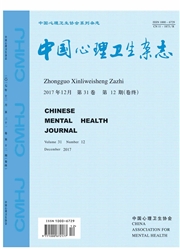

 中文摘要:
中文摘要:
目的:探讨认知行为治疗(CBT)对成人注意缺陷多动障碍(ADHD)患者静息态局部脑功能的影响。方法:被试包括10例18—65岁、符合精神障碍诊断与统计手册第4版(DSM-VI)ADHD诊断标准的患者及12例年龄、性别匹配的正常对照。对成人ADHD患者在CBT治疗前分别使用ADHD评定量表(ADHD—RS)及执行功能行为评定量表成人版自评问卷(BRIEF)进行症状、执行功能的评估,并进行静息态功能磁共振成像(rfMRI)扫描,此后进行12次CBT治疗,治疗完成后进行第2次症状、执行功能评估及MRJ扫描,以观察ADHD症状、执行功能及静息态局部一致性(ReHo)的变化;对正常对照进行一次ADHD症状、执行功能评估及M砌扫描。结果:CBT治疗后ADHD患者的ADHD症状量表总分[(43±7)vs.(31±7),P〈0.01]、注意缺陷分及多动/冲动分降低,BRIEF中的监控[(15±2)vs.(11±2),P〈0.01]及组织因子[(19±5)vs.(14±4),P〈0.01]的分数降低。在脑功能层面,治疗前,成人ADHD患者默认网络内脑区(左侧海马旁回)及双侧前扣带回ReHo值低于正常对照,治疗后,成人ADHD患者默认网络内脑区(右侧海马旁回)及额-顶网络内脑区(右侧中央前、后回及左侧中央后回)的ReHo值增高,但右侧额上回的ReHo值仍低于正常对照(P〈0.05,团块体积〉3051mm^3,校正后P〈0.01)。结论:CBT治疗可以改善成人ADHD患者的核心症状及认知功能,对默认网络内(海马旁回)及额一顶网络内(双侧中央前后回)脑区功能可能有影响,此脑功能的改变可能是ADHD症状和执行功能改善的神经基础。
 英文摘要:
英文摘要:
Objective: To determine the effects of cognitive-behavioral therapy (CBT) on resting-state brain functional changes in adults with attention-deficit/hyperactivity disorder (ADHD). Methods: Participants including 10 adults with ADHD aged 18 - 65 years, diagnosed with the Diagnostic and Statistical Manual of Mental Disorders, Fourth Edition (DSM-IV) and 12 age-and gender-matched healthy controls. The ADHD symptoms and executives functions were assessed using the ADHD Rating Scale (ADHD-RS) and Behavior Rating Inventory of Executive Function (BRIEF) respectively and resting-state functional magnetic resonance imaging were acquired before and after 12-session CBT for ADHD patients. The healthy controls were also scanned. We used the regional homogeneity (ReHo) to capture the changes of regional brain function between pre- and post-CBT in ADHD for measuring the effects of CBT. Results: After CBT, the total scores of ADHD-RS [ (43 ± 7) vs. (31 ± 7), P 〈 0.01 ], the subscale of inattention and subseale of hyperactivity/impulsivity were decreased in ADHD adults. As for the execu- tive functions, the subscales of monitor [ ( 15 ± 2) vs. ( 11 ± 2), P 〈 0. 01 ] and organization [ ( 19 _± 5) vs. ( 14 ± 4), P 〈 0. 01 ] in BRIEF were reduced significantly in adults with ADHD after CBT training. The ReHo was increased in the regions involved in default mode network and fronto-parietal network, i. e., fight parahippocampa gyms, right precentral gyrus, fight postcentral gyms and left postcentral gyms ( Voxels with P 〈 0. 05 and cluster size 〉 3051mm3, which resulted in a corrected threshold of P 〈 0. 01 determined by AlphaSim). Conelusion: These findings support that CBT could selectively modulate the regional brain function in the default mode network and fron- to-parietal network which may contribute to the improvement of ADHD symptoms and executive functions.
 同期刊论文项目
同期刊论文项目
 同项目期刊论文
同项目期刊论文
 期刊信息
期刊信息
